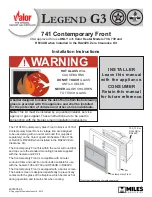
57 |
P a g e
LP GAS PRESSURE REQUIREMENTS
Inlet and manifold gas pressure checking taps are located on gas valve. These ports are only accessible from the outer
left side of the fireplace. A qualified installer shall take pressure measurements at these ports to verify and set the correct
gas pressures during the LP Kit installation and before fascia materials are installed over the front of this fireplace. Mani-
fold pressure must
be taken at the “MANIFOLD PRESSURE" tap and inlet pressure at the "INLET PRESSURE" tap
with
the burner
operating
by a qualified installer.
DESIRED
INLET
PRESSURE
MINIMUM
INLET
PRESSURE
MAXIMUM
INLET
PRESSURE
MANIFOLD
OUTLET
PRESSURE
AIR SHUTTER
POSITION
L.P. GAS
12.0" W.C
.
(2.99 kPa)
12" W.C.
(2.99 kPa)
14.0" W.C.
(3.49 kPa)
10.0" W.C.
(2.5 kPa)
1/4" OPEN
MIN.
(5 mm)
REGULATE THE FLAME HEIGHT TO "HIGH" POSITION. OUTLET GAS PRESSURES MAY VARY PLUS OR MINUS
5%.
LPG PROPER INPUT RATES:
With the proper orifices installed and the Outlet Manifold
Pressure verified to be per the table, as specified above,
this fireplace utilizing LP Gas will have a maximum input
rate of 41,000 Btu/Hr.
LEAK TESTING REQUIREMENTS
Prior to completing the conversion process, check for gas
leaks with soap and water solution at all plumbing joints
prior to placing this appliance into operation. It is recom-
mended that all gas-plumbing joints, factory installed and
field installed are checked for leaks.
Figure 21: Pressure Test Port
PILOT FLAME AND MAIN BURNER RELATIONSHIP
VERIFICATION
Prior to completing the conversion process, the qualified service technician must, light the pilot light and verify the rela-
tionship between the pilot light flames and the main burner. The pilot light flames directed towards the propagation ports
on the rear and front burner must overlap the propagation ports on the burners. The pilot light flames must be a minimum
of ¾” long and must overlap the propagation ports on both the rear and front burners as shown in the diagram, below.
Verify that the burner tubes ignite quickly and the burner flames propagate smoothly along the entire length of the burn-
ers.
PILOT FLAME LENGTH ADJUSTMENT
If the pilot light flame length is too short and the system does not maintain a standing pilot, a qualified installer may in-
crease the length of the pilot light flames to meet the two requirements: Minimum pilot light length to maintain a standing
pilot light and the pilot light flames must be long enough to overlap burner flame propagation ports.
Derating at altitudes above 2000 feet
Installation of this appliance at altitudes above 2000 feet requires the gas input rate to be derated. For LPG applications,
the main burner orifice size for altitudes above 2000 feet shall be #49. LPG gas input rate for installation above 2000 feet
shall be 40,000 Btu/Hr.
1 " M I N .
1 " M I N .












































